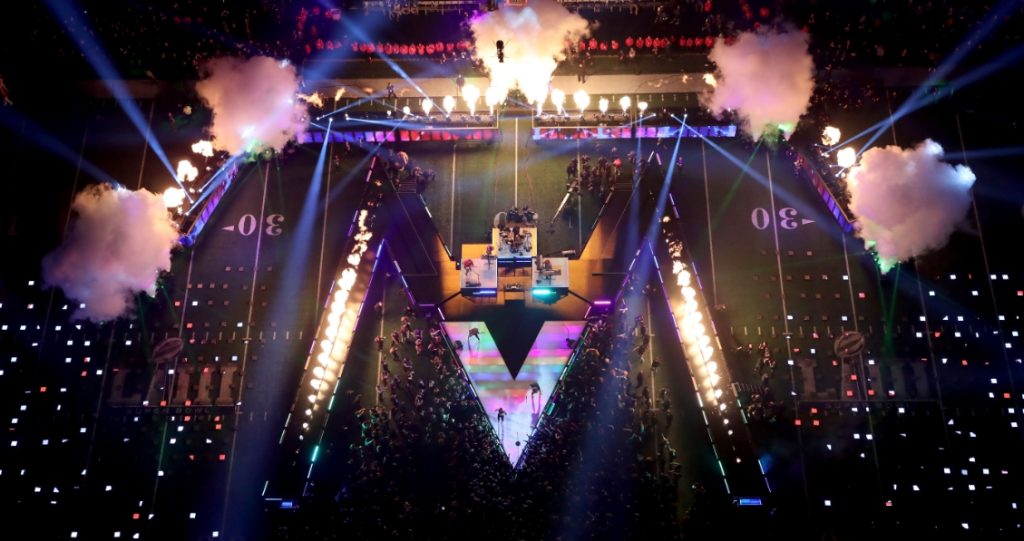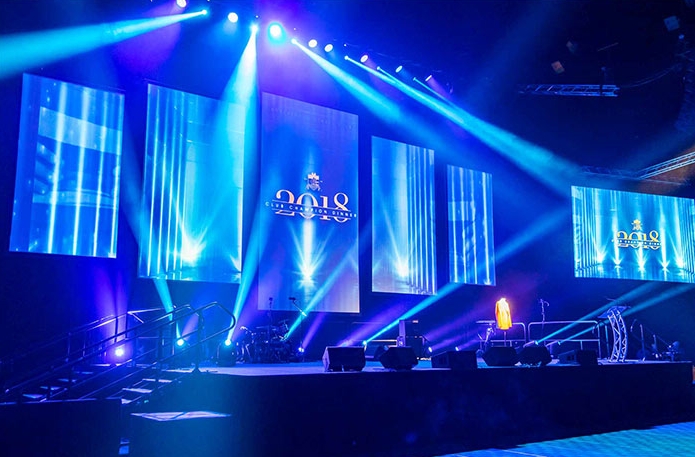LED screen overheating refers to a situation where the temperature of an LED screen rises to an excessive or unsafe level. Overheating can occur when the heat generated by the LED screen’s components exceeds the rate at which it can be dissipated or cooled down. This can lead to various issues, including reduced performance, potential damage to the screen or its components, and even system failure.
LED screens generate heat as a byproduct of their operation. The primary sources of heat are the LED backlighting, the driver circuits, and the power supply. If the heat is not effectively dissipated, it can cause the internal components to operate at higher temperatures, potentially exceeding their safe operating limits.

Dynamic stage design with LED screens
When an LED screen is overheating, several symptoms may indicate the issue. Here are some common symptoms to look out for.
Flickering or Unstable Display:
Overheating can cause the LED screen’s display to flicker, exhibit unstable images, or even go completely black at times. The heat can affect the electronic components, leading to erratic behavior of the screen.
Color Distortion or Discoloration:
Overheating may result in color distortion or discoloration on the LED screen. You may notice abnormal color shifts, such as colors appearing washed out, tinted, or inaccurate. Heat can affect the screen’s ability to display colors accurately.
Reduced Brightness:
Overheating can cause a decrease in the overall brightness of the LED screen. The screen may appear dimmer than usual, making it challenging to view the content properly. This reduction in brightness is often a result of the screen’s built-in protection mechanisms to prevent further damage from excessive heat.
Artifacts or Image Ghosting:
Overheating can introduce artifacts or image ghosting on the LED screen. These artifacts may manifest as trails or remnants of previous images persisting on the screen. The heat can affect the response time of the display, causing these visual artifacts to appear.
Screen Freezing or Shutting Down:
In severe cases of overheating, the LED screen may freeze or shut down completely. This is a protective mechanism to prevent further damage to the screen or its components. The screen may remain unresponsive until it cools down to a safe operating temperature.
Audible Fan Noise or Increased Fan Speed:
If the LED screen has built-in cooling fans, overheating can cause the fans to run at higher speeds or produce audible noise as they try to dissipate the excess heat. The increased fan activity indicates that the screen is experiencing thermal stress.
It’s important to note that while these symptoms may indicate overheating, they can also be caused by other factors such as software issues or hardware malfunctions. If you observe any of these symptoms, it’s advisable to contact the manufacturer or a professional technician who can properly diagnose the problem and provide appropriate solutions.

Several factors can contribute to the overheating of an LED screen. Here are some common causes.
Inadequate Ventilation:
Insufficient airflow around the LED screen can impede heat dissipation, leading to overheating. If the screen is placed too close to a wall or other obstructions, it can restrict the natural flow of air and trap heat inside the device.
High Ambient Temperature:
Operating the LED screen in a hot environment can increase the risk of overheating. If the surrounding temperature is already high, it can add to the heat generated by the screen itself, making it difficult for the internal components to cool down effectively.
Intense Usage or High Brightness:
Running the LED screen at maximum brightness for extended periods or continuously can generate more heat. Similarly, subjecting the screen to heavy usage, such as displaying graphics or videos with high processing requirements, can increase the heat output.
Inadequate Cooling Mechanisms:
LED screens are designed with cooling mechanisms like heat sinks, fans, or thermal pads to dissipate heat. If these mechanisms are damaged, clogged with dust, or not functioning optimally, they may fail to effectively transfer heat away from the screen, leading to overheating.
Insufficient Maintenance:
Lack of regular cleaning and maintenance can lead to the accumulation of dust, dirt, or debris on the screen’s ventilation openings, obstructing airflow and impeding heat dissipation. Over time, this can contribute to overheating issues.
Electrical Issues:
Problems with the power supply, such as voltage fluctuations, unstable current, or inadequate power capacity, can cause the LED screen to overheat. It is essential to ensure that the screen is connected to a stable and appropriate power source that meets the manufacturer’s specifications.
Manufacturing Defects:
In some cases, manufacturing defects or poor quality control can result in inadequate heat dissipation capabilities or other design flaws that contribute to overheating.

If you are experiencing overheating issues with an LED screen, there are several solutions you can try to mitigate the problem. Here are some potential solutions.
Ensure Adequate Ventilation:
Make sure that the LED screen is installed in a well-ventilated area. Provide sufficient space around the screen to allow for proper airflow. Avoid placing the screen too close to walls or other objects that could block ventilation.
Check and Clean Ventilation Openings:
Regularly inspect the ventilation openings on the LED screen and clean them to remove any dust, dirt, or debris that may be obstructing airflow. Use appropriate cleaning techniques and tools recommended by the manufacturer.
Monitor Ambient Temperature:
Keep an eye on the ambient temperature of the environment where the LED screen is located. If the temperature is consistently high, consider implementing cooling measures such as fans, air conditioning, or installing the screen in a cooler area of the room.
Adjust Brightness Levels:
Reduce the brightness level of the LED screen if it is set to maximum or unnecessarily high levels. Running the screen at lower brightness levels can help reduce heat generation.
Limit Usage Intensity:
If the LED screen is subjected to heavy usage, such as displaying resource-intensive graphics or videos, consider reducing the intensity or duration of usage. Allowing the screen to rest periodically can help prevent excessive heat buildup.
Check Cooling Mechanisms:
Inspect the cooling mechanisms of the LED screen, such as fans, heat sinks, or thermal pads, and ensure they are functioning properly. Clean or replace any damaged or clogged components that are impeding heat dissipation.
Verify Power Supply:
Check the power supply and ensure that it meets the manufacturer’s specifications. Unstable or inadequate power supply can contribute to overheating. Consider using a surge protector or voltage stabilizer to regulate the power source.
Consult Manufacturer or Technician:
If the overheating issue persists or if you are unsure about the appropriate steps to take, it is advisable to contact the manufacturer or consult a professional technician who specializes in LED screens. They can provide specific guidance and solutions based on the screen’s model and specifications.
In summary, to prevent LED screen overheating, it is important to ensure proper ventilation, maintain an appropriate operating environment, monitor the screen’s temperature, and follow the manufacturer’s guidelines for usage and maintenance. Regular cleaning, avoiding excessive usage intensity, and addressing any cooling or power supply issues can also help mitigate the risk of LED screen overheating.